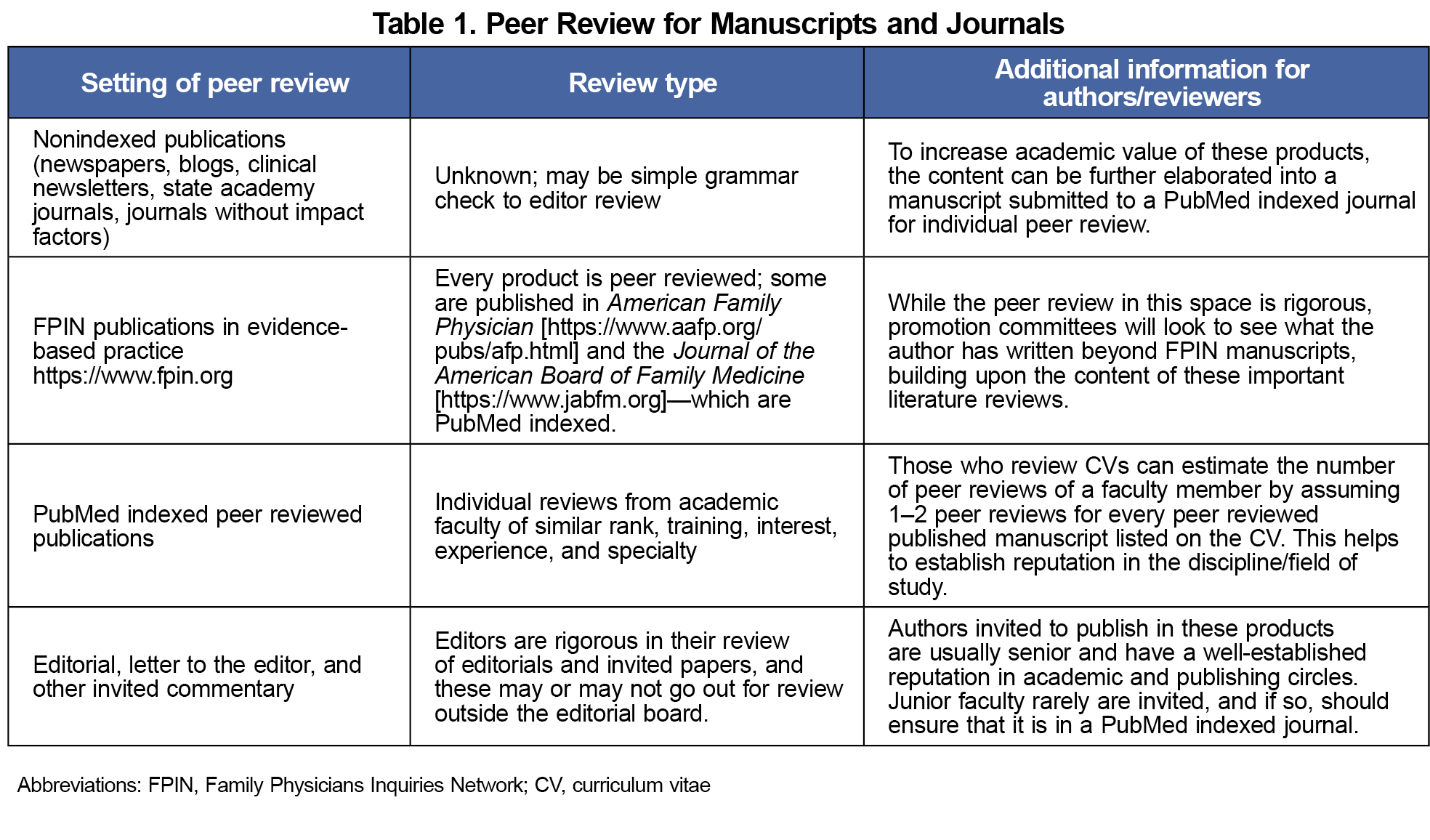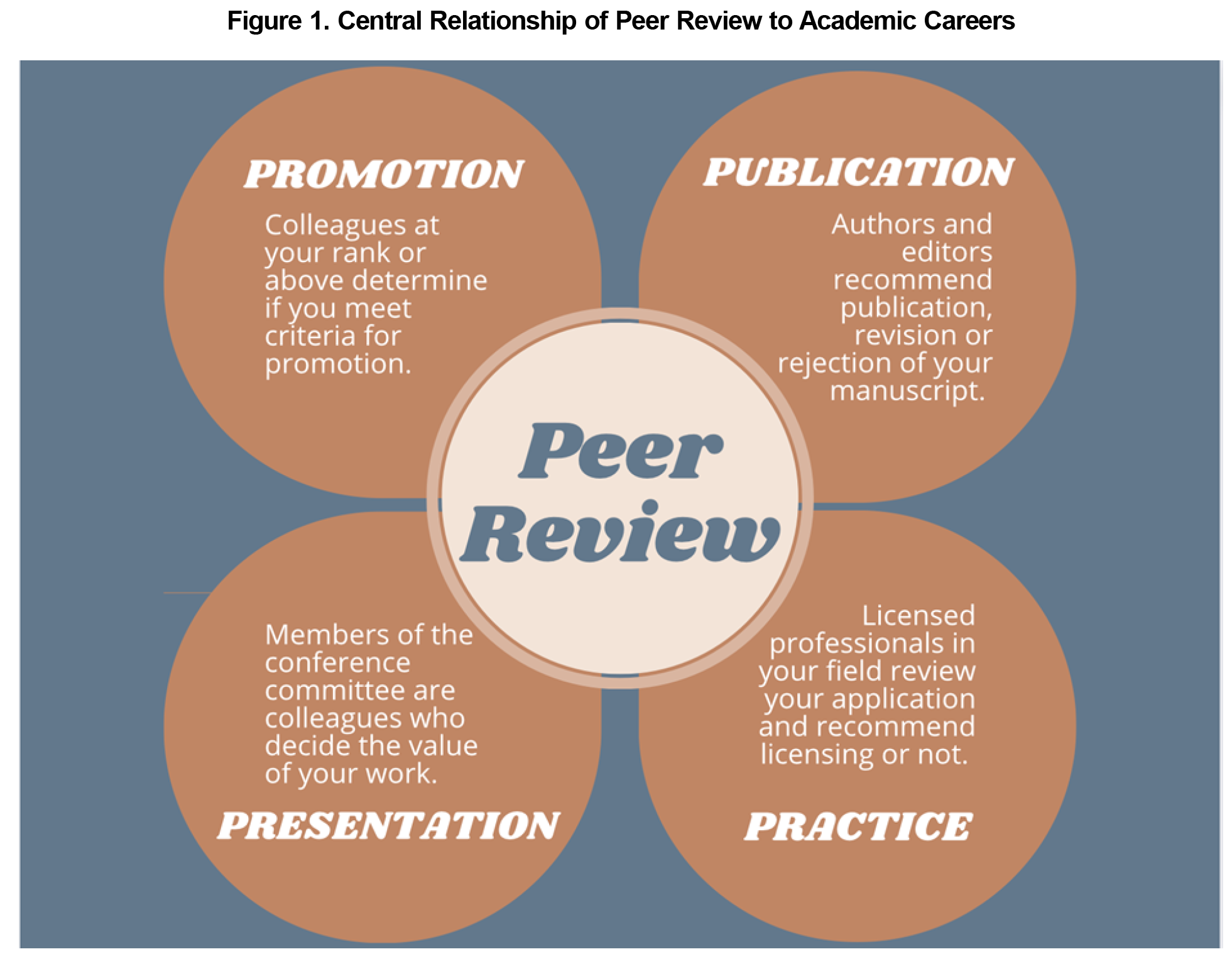Achieving promotion and tenure can be an important marker of academic success for any faculty member. Early career faculty may benefit from demystifying the elements needed in a promotion packet and the relative importance of those elements as they are reviewed by institutional promotions committees. Excellence in education, clinical care, and research or scholarship are required to varying degrees in promotion criteria.1 Peer review is the process by which promotion committees and external referees ascribe value to the various components documented on the curriculum vitae (CV).2 While commonly thought of primarily in the context of reviewing manuscripts, peer review is, in reality, much more central than that for advancement in our academic careers.3,4 In this professional development perspective, we define peer review; discuss its importance in our model of the 4 Ps—publication, presentation, promotion, and practice; and encourage faculty interested in academic advancement to actively participate in peer review in multiple domains.5-8 We also illustrate the importance of recruiting colleagues more often to perform peer reviews. Serving as a peer reviewer in any capacity is a critical and vital service to the discipline and ensures that our scholarship is high quality, rigorous, and reflects a diversity of thought and expertise. In academia, no one progresses from instructor level to full professor without participating in peer review.
PROFESSIONAL DEVELOPMENT PERSPECTIVE
Peer Review Is Primary: Presentations, Publications, Promotions, and Practice
Kendall M. Campbell, MD | Edgar Figueroa, MD, MPH | Donna Baluchi, MLIS | José E. Rodríguez, MD
PRiMER. 2024;8:42.
Published: 8/5/2024 | DOI: 10.22454/PRiMER.2024.148162
Peer review is primarily thought of as the process used to determine whether manuscripts are published in medical or other academic journals. While a publication may be one outcome of peer review, this article shares a model of 4 Ps to remind faculty of some important additional applications of peer review. The 4 Ps are publication, presentation, promotion, and practice. The medical literature offers few reasons why faculty should get involved in peer review. In this article, we define peer review, illustrate the role of peer review in four important processes, describe how the volume of material to review has changed over time, and share how participation in these processes promotes career advancement. Understanding the peer review process and its benefits can encourage professionals to participate in peer review in any of the four Ps as they recognize the benefits to their discipline and their career.
Table 1 describes multiple writing products that are available in family medicine journals and other places. Authors can peer review for the journals in which they seek publication, such as evidence-based practice and PubMed indexed journals. These reviews require reading and assessing the quality of the manuscript, checking references, and fact-checking manuscript claims. Faculty can choose how often they review articles, but frequent reviewing helps reviewers gain experience with publication, improve their writing skills, and enhance their CV.5,9,10
Peer review also can be used to determine which presentations are accepted for conferences. Some family medicine conferences use a committee of peers to review each submission and to select presenters. Peer reviewers for conference presentations spend time reviewing submissions and choosing the best ones, with the goal of ensuring high-quality offerings for conference attendees.11-13 In this type of review, the materials presented may be abstracts, responses to prompts required in the submission, and relevance to the conference themes and categories. Overall, this could be a significant volume of material to review for each presentation, and many reviews may be required in a short time frame. Reviewing presentation proposals benefits the individual faculty member performing the review in that it helps define what is important in the discipline and can serve as inspiration for projects or processes in their career.
Academic advancement depends on the skills developed in reviewing presentations and publications, as well as on the academic medicine community employing those skills to review promotion packets. Promotion review can take a long time, and it requires a detailed, rigorous assessment, which is well-documented in the literature.14,15 Teaching, research, and clinical statements, individuals’ publication portfolios, and national and international reputation are all evaluated in the promotion review. This is a time-consuming and volume-intensive review. Because of the low numbers of family medicine faculty in tenure lines at the professor rank,16-18 few are qualified to review promotion packages of those seeking promotion to full professor.19,20 In addition, those who are seeking promotion may be reviewed by those at the level they are seeking or above (eg, associate professors can evaluate those being promoted to assistant professors) This type of reviewing too can be added to your CV, can help others in the field advance, and can help inform individuals as to the activities that are valued in promotions at other institutions.
Peer review for practice takes on many forms. When we apply for a state license, the state medical board reviews our application. They are our peers. When we apply for privileges in a hospital system, the credentialing board also reviews our application. These boards are also made up of our peers, and frequently they will ask peers not on the board to review applications. While reviewing applications for licensure is not the same as reviewing for publications, presentations, or promotions, the skills gained by reviewing manuscripts, presentations, and promotion packets can be transferred to reviewing applications for practice and credentialing. This type of review has direct benefit for our patients by ensuring that those who treat them have met minimum qualifications and keeps the reviewer abreast of advances in the requirements for patient care.
In this article we have further characterized how peer review is at the heart of four major activities in an academic career: publication, presentation, promotion, and practice (Figure 1). In summary, the peer review process is fundamental for academic medicine faculty who are seeking promotion to the next rank. In sharing levels of review, we have defined the highest level as an individual review by a faculty peer of similar rank, training, expertise, interest, and specialty. We have further shared that those who review CVs and other promotion documents can estimate the number of peer reviews a faculty member has received and use that information for decision-making regarding promotion.
The peer review activities presented in this article can be listed on the faculty member’s CV under the heading “Service to the Profession.” Entries can include journals for which you review, service on committees that review presentations, credentialing applications, and promotions/tenure.
Peer review is so central to our discipline that it behooves all of us to participate as reviewers, in publication, presentation, promotion, and practice. Early career faculty can begin peer reviewing for journals as soon as they get their first faculty appointment. Peer review also can be the nidus of ideas that inspire the reviewer, improve the reviewer’s knowledge base, and provide a source of continuing medical education credits.9 Reviewing the work of others for publication, presentation, promotion, or practice not only serves the discipline, but it helps the individual reviewer become a better author, presenter, and evaluator of academic and practicing health care providers. In short, peer review is a primary activity for family medicine faculty.
Acknowledgments
The authors acknowledge the Society of Teachers of Family Medicine and the American Board of Family Medicine Foundation for their ongoing support of the Leadership Through Scholarship Fellowship through which this work has been made possible.
Financial Support: This work is partially supported by the Society of Teachers of Family Medicine and the American Board of Family Medicine through a grant to fund the Leadership Through Scholarship Fellowship.
Presentations: Some of the content from this manuscript was presented at the 51st Annual North American Primary Care Research Group’s meeting, October 31 to November 3, 2023, San Francisco, California, in a session entitled “Peer Reviewing: A Workshop With Editors of Family Medicine Journals.”
References
- Milner RJ, Flotte TR, Thorndyke LE. Defining scholarship for today and tomorrow. J Contin Educ Health Prof. 2023;43(2):133-138. doi:10.1097/CEH.0000000000000473
- Campbell KM, Rodríguez JE. Gearing up: accelerating your CV to promotion and tenure. PRiMER. 2024;8(1):1. doi:10.22454/PRiMER.2024.782013
- Smith R. Peer review: a flawed process at the heart of science and journals. J R Soc Med. 2006;99(4):178-182. doi:10.1177/014107680609900414
- Kelly J, Sadeghieh T, Adeli K. Peer review in scientific publications: benefits, critiques, and a survival guide. EJIFCC. 2014;25(3):227-243.
- Morley CP, Prunuske J. Conducting a manuscript peer review. PRiMER. 2023;7:35. doi:10.22454/PRiMER.2023.674484
- Peh WC. Peer review: concepts, variants and controversies. Singapore Med J. 2022;63(2):55-60. doi:10.11622/smedj.2021139
- Frasca D. Writing an effective peer review. Fam Med. 2023;55(8):566. doi:10.22454/FamMed.2023.616815
- Watling C, Ginsburg S, Lingard L. Don’t be reviewer 2! reflections on writing effective peer review comments. Perspect Med Educ. 2021;10(5):299-303. doi:10.1007/S40037-021-00670-Z
- Sempokuya T, McDonald N, Bilal M. How to be a great peer reviewer. ACG Case Rep J. 2023;9(12):e00932. doi:10.14309/crj.0000000000000932
- Morley CP, Grammer S. Now more than ever: reflections on the state and importance of peer review. PRiMER. 2021;5(36):36. doi:10.22454/PRiMER.2021.216183
- Deveugele M, Silverman J. Peer-review for selection of oral presentations for conferences: are we reliable? Patient Educ Couns. 2017;100(11):2,147-2,150. doi:10.1016/j.pec.2017.06.007
- Ioannidis JPA, Berkwits M, Flanagin A, Bloom T. Peer review and scientific publication at a crossroads: call for research for the 10th International Congress on Peer Review and Scientific Publication. JAMA. 2023;330(13):1,232-1,235. doi:10.1001/jama.2023.17607
- Culmer N, Drowos J, DeMasi M, et al. Pursuing scholarship: creating effective conference submissions. PRiMER. 2024;8:13. doi:10.22454/PRiMER.2024.345782
- Weidner A, Brazelton T, Altman W. The challenges of external letters for promotion: academic family medicine’s attempts to address the issue. Ann Fam Med. 2023;21(6):559-560. doi:10.1370/afm.3061
- Minor S, Stumbar SE, Drowos J, et al. Writing an external letter of review for promotion. PRiMER. 2023;7:34. doi:10.22454/PRiMER.2023.447836
- Xierali IM, Nivet MA, Syed ZA, Shakil A, Schneider FD. Recent trends in faculty promotion in U.S. medical schools: implications for recruitment, retention, and diversity and inclusion. Acad Med. 2021;96(10):1,441-1,448. doi:10.1097/ACM.0000000000004188
- Xierali IM, Nivet MA, Rayburn WF. Diversity of department chairs in family medicine at US medical schools. J Am Board Fam Med. 2022;35(1):152-157. doi:10.3122/jabfm.2022.01.210298
- Fisher ZE, Rodríguez JE, Campbell KM. A review of tenure for Black, Latino, and Native American faculty in academic medicine. South Med J. 2017;110(1):11-17. doi:10.14423/SMJ.0000000000000593
- Salajegheh M, Hekmat SN, Macky M. Challenges and solutions for the promotion of medical sciences faculty members in Iran: a systematic review. BMC Med Educ. 2022;22(1):406. doi:10.1186/s12909-022-03451-2
- Mullangi S, Blutt MJ, Ibrahim S. Is it time to reimagine academic promotion and tenure? JAMA Health Forum. 2020;1(2):e200164. doi:10.1001/jamahealthforum.2020.0164
Lead Author
Kendall M. Campbell, MD
Affiliations: Department of Family Medicine, University of Texas Medical Branch, Galveston, TX
Co-Authors
Edgar Figueroa, MD, MPH - Weill Cornell Medicine, New York, NY
Donna Baluchi, MLIS - Spencer S. Eccles Health Sciences Library, University of Utah, Salt Lake City, UT
José E. Rodríguez, MD - Department of Family and Preventive Medicine, University of Utah Health, Salt Lake City, UT
Corresponding Author
José E. Rodríguez, MD
Correspondence: Department of Family and Preventive Medicine, University of Utah Health, Salt Lake City, UT
Email: Jose.rodriguez@hsc.utah.edu
Fetching other articles... 
Loading the comment form... 
Submitting your comment... 




There are no comments for this article.